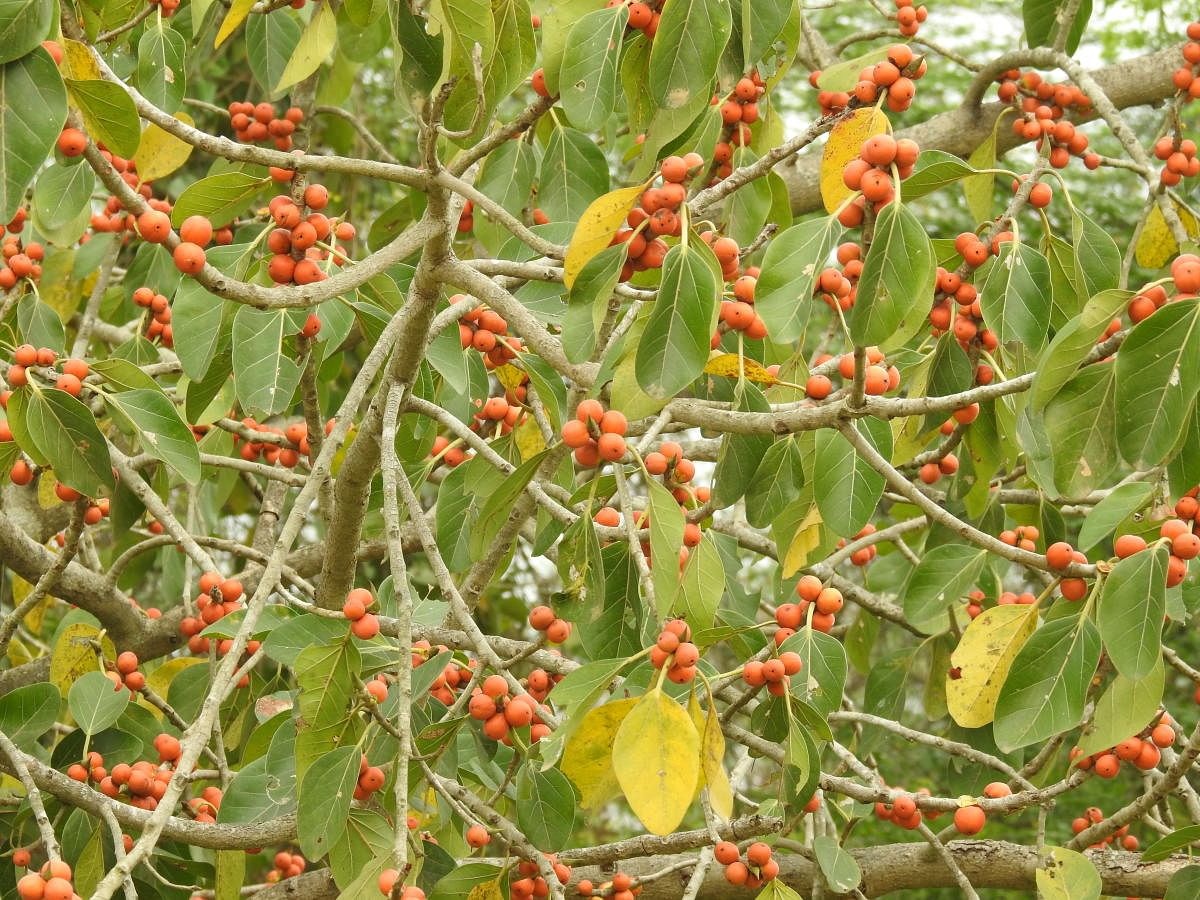
As many as 30 wild fruit species have flourished beneath a cluster fig tree in Kalave in Sirsi in Uttara Kannada district. This is made possible by hundreds of seed-dispersing frugivores and small carnivores which make the tree their home or hunting ground. “Plant a fig sapling and the other species arrive on their own. This tree attracts more birds, insects and mammals than any other tree in the vicinity,” says Shivananda Kalave, the custodian of the tree.
It is this capacity of the figs (ficus species are commonly called as figs) to vegetate an area and nurture an ecosystem that attracted Mangaluru-based veterinarian Manohar Upadhya and his dentist wife Vidya towards these complex tree species. Online research and exploration helped them understand the potential of figs to grow forests on their own.
“It is fascinating to see the ecosystem services offered by ficus species. They might not bring us monetary benefits. Our priority is to restore degraded lands and improve green cover for forest species to thrive,” Manohar says.
The couple bought seven acres of dry land in Bantwal taluk two years ago only to grow a fig forest. While they have planted 66 plants of 22 fig species, the aim is to collect at least 50 of the 96 species found in the country.
Conservation model
In Uttara Kannada district, the forest department has developed a unique conservation model centred around ficus.
Over a decade ago, the laterite plateau between Kumta town and the Arabian sea faced the threat of encroachment. As nothing but grass grew over these laterite rocks, people found it convenient to encroach high-value pockets of land that were managed by the forest department.
Krishna Udapudi, then Deputy Conservator of Forests (DCF) of Honnavar division, noticed this problem in Honnavar and Bhatkal towns as well. In 2010, he decided to protect the land by growing a ficus forest.
“They have the ability to survive in diverse ecosystems and tough terrains. And this feature has made them critically important in conservation,” he says.
Over a period of three years, around 10,000 plants were planted in an area of 250 acres in these three coastal towns. Of them, 60% were fig plants and the rest were other native species.
Eight years have passed since and the fig plants have served multiple purposes apart from protecting the land: they have turned into microsites for conservation.
Fans of the fig
While figs continue to be the favourite of bonsai enthusiasts, ficus-centred ecosystem revival efforts are gaining popularity in recent years.
And in the process, the focus has shifted from economic returns to the ecosystem value of a tree.
In Melkote, Janapada Seva Trust celebrated Environment Day this year by planting ficus plants on 10 acres of land. These keystone species of tropical forests play a crucial role in our fight against environmental destruction, says Santosh Koulagi of Janapada Seva Trust.
This is also an effort to bring back the eight ficus species that were once commonly seen in the region. “We have lost almost all the plants: irrigation and erosion of our knowledge regarding these plants that once played a key role in farming by facilitating pollination and pest control are the main causes. We need to nurture the ecosystem for posterity and ficus is crucial in achieving this,” he says.
The one-acre peepal tree orchard interspersed with banyan, teak and local species in Puttur taluk has caught the attention of people in Dakshina Kannada. “Many have planted at least one or two plants near their house or in their farm, while some gram panchayats have come forward to grow ficus gardens in villages. Its religious and spiritual significance and the belief that ficus produces more oxygen have added to its popularity,” says Shreesha Kumar, a lecturer in Puttur, who has nurtured the orchard.
Strategy to sustain
Shivananda Kalave concurs, “The practices and beliefs linked to ficus have helped them survive despite their lack of commercial value. Every village, town or city has an Aralikatte or Ashwatha katte. A decade ago, I visited a village in Kumta which had over 40 ficus plants with platforms built under its canopy.”
While Janapada Trust and Shreesha got the saplings from the Forest Department, Manohar has been collecting the diverse species from nurseries.
Afforestation centred around ficus or fig plants or other native species is not new in the state. Figs grown as avenue plants in different parts of the state testify this.
“We have always ensured that 10 to 20% of the plants in our afforestation programmes is ficus species,” says Sanjay Mohan, Principal Chief Conservator of Forests, Karnataka.
The forest department has grown nearly 2,000 ficus plants near Tannirbhavi beach under a CSR initiative, says Mangaluru Range Forest Officer P Sridhar.
However, conservationists observe that the ficus lost importance after the department and individuals gave preference to timber trees and those with commercial value.
Survival by coexistence
Dr Sanjeev Kulkarni, who has grown 10 ficus species in his forest farm, Sumana Sangama, in Dharwad, has observed survival by coexistence in the symbiotic relationship fig tree shares with fig wasps and other creatures.
While numerous species of wildlife need fig for food and for home, the tree is dependent on them for regeneration. The life around this tree makes the soil fertile, which in turn helps farmers.
“Private forests are a welcome concept, that too when the stress is on ficus species that are the hotspots of biodiversity,” he says.
